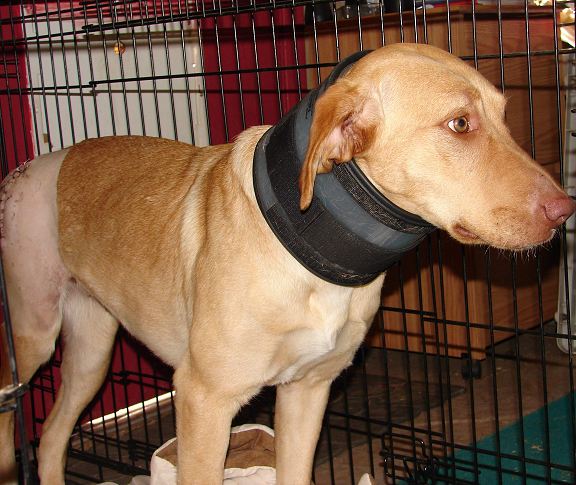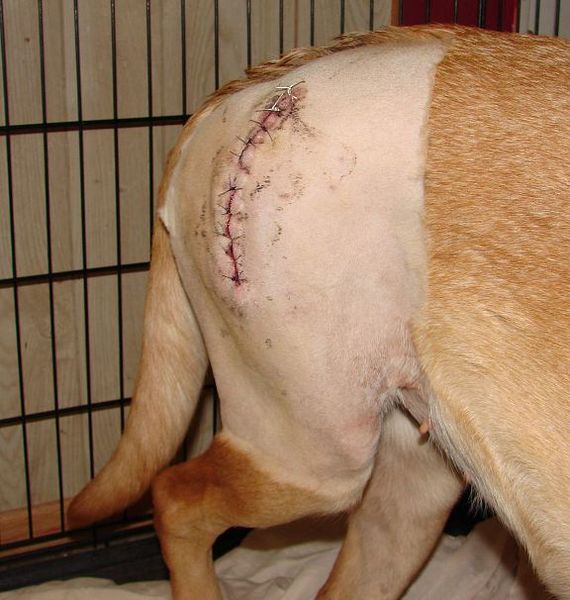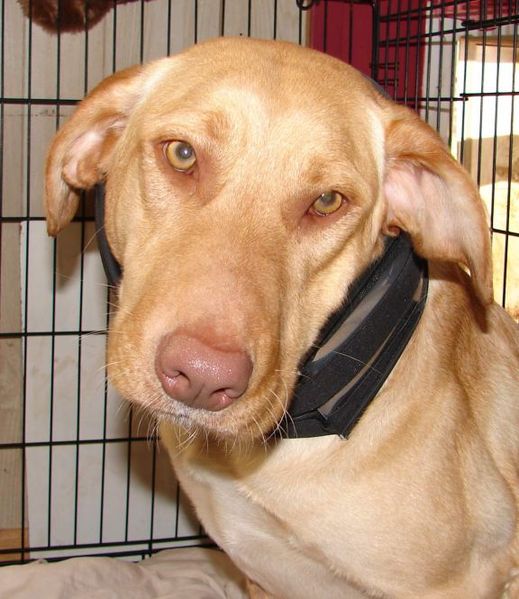Thanks to a fundraiser we were able to get her the best care. Thank you to everybody who got involved!!!






By Angelia Joiner
Special to the Reporter-News
Tuesday, February 17, 2009

Courtesy photo Birgit Sommer, a wildlife rehabilitator in Erath County, says she also cares for domesticated animals.
Kindhearted humans sometimes find -- and try to take in -- young birds, squirrels, fawns or rabbits that appear to be abandoned.
Roy Johnson, Taylor County game warden, said most of the time this is not the case.
"Mother Nature has a way of taking care if itself," Johnson said. "If you see a fawn, I promise you the mama has not abandoned it. She will come back and take care of it."
He said the same is true for other animals.
Johnson said the exception is when someone sees a dead mother. The fawn will not leave it, and in that case, the fawn should be taken to a licensed rehabilitator -- but those are hard to find.
"There are no rehabilitators in Abilene. The closest is Breckenridge or Baird," Johnson said. "I've encouraged four people to get a license, but they don't follow through because it is extremely difficult to obtain and it's at their own expense."
Johnson said to find someone in the area, go to www.tpwd.state.tx.us -- but be prepared to drive to them or to meet them somewhere.
Sometimes, he said, fawns can be seen lying on or near the road. To keep them from being injured, they can be moved and placed over a fence.
"It's a rumor that a deer won't come back to its baby once it's been touched by humans," Johnson said. "That's not true."
Birgit Sommer, a licensed wildlife rehabilitator in Erath County, said the same is true for most animals. The human touch myth is "just an old wives' tale." And if a baby is found, it's best to try and reunite with the mother if possible.
Sommer specializes in caring for squirrels, but also cares for other wild critters and all kinds of domesticated animals.
She said February is the time of year when young squirrels are often knocked out of their nests. The best policy she said is to place the baby squirrel in a shoe box at the base of the tree where it was found. Because they chill easily, a plastic bottle can be filled with warm water and wrapped in a T-shirt to keep the young animal warm. Sommer said to avoid using terry cloth in the box because the tiny claws will become snagged.
If the baby squirrel could be in danger from predators, such as dogs, tie a basket to the tree.
Most likely, the mother will come back for her offspring if she feels safe to do so; it is best to observe from a distance.
It's a different matter for baby squirrels found during the evening hours.
"Squirrel mothers will not come back at night, so try putting it out first thing in the morning," Sommer said.
Squirrel feeding is difficult, so it's best to take the young to a trained professional because they aspirate easily, she said.
Sommer also has raised opossums successfully. She noted that opossums often are often struck and killed by automobiles.
She said that if an animal is hit, it's good to check the pouch for surviving babies.
"These are the only marsupials in North America and often times, the infants will still be alive -- protected by the pouch," Sommer said. "And they are not known to carry rabies, either."
Baby birds
Young birds are commonly found on the ground, she said.
"Fledglings may look like they are unable to be on their own, but the parents are still caring for these fledglings and keep track of where they are. So the baby bird you see may be a fledgling that is being taken care of by its parents still."
Sommer said that if the bird is not fully feathered, the best thing to do is to put it back into the nest.
"A baby bird might need to eat every 20 minutes in daylight hours depending on its age and species," Sommer said. "The parents can take care of it so much better than you can."
Sommer cautions that if people find wild baby bunnies during the day, "leave them alone." Many folks think they have been abandoned and most times they have not, she said.
Rabbits don't feed their young very often and usually only nurse for about five minutes a day, returning to the nest only once or twice in a 24-hour period.
"If the babies' bellies look plump, then they've been fed," Sommer said. "If a nest has been destroyed, you can rebuild it within 10 feet of its original spot."
Sommer said that if you know for certain that the mother rabbit is dead, locate a rehabilitator because infant rabbits have a high mortality rate, especially cottontails.
Following the law
Johnson, the game warden, said it is against the law to keep any live game animal and that should be considered when someone is contemplating keeping a baby animal they've found.
Before she gained her license, Sommer said, the Erath County game warden fined her $150 for caring for baby squirrels and the action prevented her from obtaining the license for one year.
She said the licensing process is incredibly difficult and because of the expense of buying formula and building shelters, etc., she believes this is why there are so few licensed rehabilitators.
For more information on animals or guidance in acquiring a license, contact Sommer at www.rainbowwildlife.com.
An 18th-century German philosopher from the Prussian city of Konigsberg once said, “He who is cruel to animals becomes hard also in his dealings with men. We can judge the heart of a man by his treatment of animals.” Immanuel Kant is to this day regarded as one of the most influential thinkers of modern Europe and when I came across this well put quote the wheels began to turn in my brain and tug at my heart strings.
In preparing for the Dog Park proposal that Birgit and I took before the City Council on Jan 13th, I visited a ton of websites devoted to pets and animal laws and their legal rights as well. From a link on one site I came across www.pet-abuse.com that lists animal abuse case within 100+ miles of your zip code, but please head my warning: the details are incredibly graphic and disturbing. I was heartbroken so some people may not want to read the cases—part of me wished that I hadn’t honestly. Every case I opened was worse than the last and I was mortified. How can a human being hurt a defenseless animal?
When I first stepped foot into the Erath County Humane Society a few months back, I had stopped in just to take my two year old daughter to look at the animals. I chatted with Judy, the animal “savior” of the facility and I really felt bad for some of the sweet little animals that were there some of whom had been abandoned by reckless owners and others were caught in traps strayed or orphaned, struggling to grow up and all lonely for the love and affection only a real family can give to them. Judy and her grandson have devoted themselves entirely to their cause working 365 days a year without the financially rewards that they should be receive.
The moment I walked out the door I wanted to know what I could do to help. On my next visit to the Shelter I brought a couple of gallons of bleach which is always one of the main necessities of the shelter because it helps disinfect and keep the kennels disease free and as clean as a place like that possibly could be. The bleach is always at the top of the “Wish List” and if you would like to do something nice that isn’t a big hit to your wallet, you can always get a couple of gallon jugs from the Dollar Store and drop them off any time. If you do so and the shelter is not open at that time you can set them over the fence and they will be taken in by the Animal Control Officer when he stops by later. Anyways~ She told me some stories about her recent successful adoptions and foster families but also some sad tales of how some of the puppies in the back fenced in part of the property had come to be shelter residents. A woman had stopped in her car by the side of the road when she noticed a black trash bag moving in the middle of the street. She tugged the bag open to find four puppies left for dead.
How can someone be so sick and heartless? When I think puppies, I think of fuzzy little warm bodies wagging their tails in excitement from any affection, the smell of sweet puppy breath, soft little bellies and lovable eyes looking at you like you hung the moon. Most people would not throw out their garbage on the highway partly out of obligation to abide by the law, partly for respect for their city roads but mainly from simple common sense!
This all has me thinking: Where do I stand in my views on animal rights? Of course I HATE the idea that anyone would intentionally cause an animal pain, but I am nowhere near being a “tree huggin’ hippie” as my husband so graciously refers to it. How far will I take this? I am a good ol’ Texas girl who loves the smell of a juicy steak cooking on the grill. Half of my freezer is stocked with elk, antelope and wild boar meat; kills from my father’s many hunts which he goes on so that we have tons of meat. So no jumping on the PETA bandwagon for me. (A funny side note on that though- PETA’s most recent efforts to protect animals has now stretched to include the slimy scaley fish as well and they are attempting to rename them “sea kittens” so that people will feel guilty ordering the fish of the day AKA “sea kitten of the day. To me that is totally over the top and ridiculous.
When a hunter covers himself in deer urine and steps into his heated deer blind with some 40 caliber semi-automatic weapon that is better suited bringing down Al Queda Leaders than the year old deer eating from the strategically placed corn feeder, that aint cool to me!
I have a rescued Chihuahua French Bulldog mix from San Francisco, 2 rescue cats both from Stephenville, 2 “feeder fish” that have somehow or other outlived any other fancy expensive breed of fish I’ve ever purchased, 17 adopted goats and a donkey that watches over us all. My husband, daughter and myself love our modest property and our extended “family” of animals that will soon be expanding to include 6+ chickens.
I will continue to work in the right direction- it’s all I can do. This dog park is important to me because with the state of the economy, people are having to work more and more to make ends meet which does leave a lot of dogs stuck inside all day or in the yard with no outlet for built up energy who after a while can start to act out up chewing favorite shoes or scratching up the doors for attention. If some of that energy can be burned up in a healthy way by playing with other dogs in a safe environment and running until their hearts are content then I truly believe there will be many fewer cases of dog abuse or animals jumping or digging out of fences. Plus, the shelter can use the dog park as a place to showcase their adoptable dogs to help unite responsible owners with the perfect, loving animal for them. So, “Give me your tired, your poor, your huddled masses yearning to breathe free, the wretched refuse of your teeming shore. Send these, the homeless, tempest-tost to me. I lift my lamp beside the golden door!”
Heartbroken by the thought of the millions of mistreated and abandoned animals taken in by shelters each year, Rachael Ray has created the Rachael’s Rescue website to highlight organizations that are dedicated to helping animals in need. Below are some of Rachel’s favorite organizations:
The largest no-kill animal adoption
and rescue organization in the world
Since 1944, The League’s mission has been to save the lives of pets through adoption, rescue, spay/neuter and advocacy initiatives. Every year, the League reaches across the country to rescue, nurture and adopt nearly 20,000 pets into happy and loving homes. To date, the League has placed close to 1 million puppies, kittens, cats and dogs into carefully screened homes. One of the first animal rescue agencies on the ground in the aftermath of Hurricanes Katrina and Rita, the League rescued more than 1400 pets from the region.
Securing the future of the American Pit Bull
Terrier as a cherished family companion
The Bay Area Doglovers Responsible About Pitbulls (BAD RAP) is a small and active nonprofit organization of pit bull owners, trainers, educators, rescuers and supporters. BAD RAP evolved out of a desire to respond to the difficult issues facing this misunderstood breed.
The ASPCA was founded in 1866 as the first humane organization in the Western Hemisphere. The Society was formed to alleviate the injustices animals faced then, and we continue to battle cruelty today. Whether it’s saving a pet who has been accidentally poisoned, fighting to pass humane laws, rescuing animals from abuse or sharing resources with shelters across the country, we work toward the day in which no animal will live in pain or fear. Come and join us in the fight to end animal cruelty – become an ASPCA Member today!